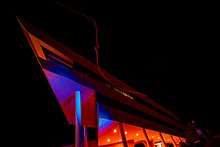Embry–Riddle Aeronautical University, Prescott
|
| |
| Established | 1978 |
|---|---|
| Chancellor | Dr. Frank Ayers |
| Undergraduates | 2,600[1][2] |
| Postgraduates | 57[1][2] |
| Location | Prescott, Arizona, United States |
| Campus | Rural, 539 acres |
| Colors | Blue, Yellow and Gold |
| Athletics | NAIA, California Pacific |
| Nickname | Eagles |
| Mascot | Ernie the Eagle |
| Website |
prescott |
Embry–Riddle Aeronautical University, Prescott is a residential campus of Embry-Riddle Aeronautical University in Prescott, Arizona. The university offers bachelor, master's, and PhD degree programs in arts, sciences, aviation, business, engineering, and security & intelligence. The Prescott campus also offers a master's degree in Safety Science, Security & Intelligence, and Cyber Intelligence & Security.

History
Embry-Riddle began in 1925 as the Embry-Riddle Company, an aircraft dealer, and airmail provider, founded by Talton Higbee Embry and John Paul Riddle in Cincinnati, Ohio. Embry-Riddle was eventually incorporated into what is now American Airlines, before reforming during the buildup to World War II in Miami, Florida as the Embry-Riddle School of Aviation, and later, the Embry-Riddle Aeronautical Institute. Embry-Riddle moved to Daytona Beach, Florida in 1965 and was renamed Embry-Riddle Aeronautical University in 1970.
Embry-Riddle opened its second campus in Prescott, Arizona in 1978.[3] Embry-Riddle purchased the former campus of Prescott College, which closed abruptly in 1974 from financial hardship.[4]
Campus
The 539-acre (2.18 km2) campus is located among Arizona's Bradshaw Mountain Range approximately 3 miles (4.8 km) from Prescott's airport, Ernest A. Love Field. All campus life is centered in a one-mile (1.6 km) area. The University's campus in Prescott, Arizona is 100 miles north of Phoenix. The high-desert climate offers nearly 300 days of sunshine a year. The campus has an enrollment of about 2,600 students and is covered in north western terrain.

Academic buildings
The Aerospace Experimentation and Fabrication Building (AXFAB) holds a fabrication suite with a machine shop and two connected fabrication areas for senior design projects. The Material Science Lab and Materials Testing Lab are also housed in AXFAB, along with the Structures Lab and the Structural Dynamics Lab. The Space Systems lab houses a satellite ground station which operates on amateur radio bands as well as equipment to allow students to simulate attitude control of satellites. The Composites Lab enables students to fabricate composite parts and the Rapid Prototyping Lab contains stereo-lithography printers for student use.
The King Engineering and Technology Center is where most of the Electrical Engineering and Computer Engineering classes occur. This building contains a Design Suite for Autonomous Vehicles and Freshman Engineering Lab which allow students to build robots, lighter-than-air vehicles, and more. The Control Theory Lab, Digital Circuits Lab, and Linear Circuits Lab all give students the hands-on experience in electronics. The Power Lab lets students design, fabricate, and test power electronics, and the Senior Design Suite is a place for students to work on their capstone projects.
The Tracy Doryland Wind Tunnel Laboratory contains an Aerodynamics laboratory with four wind tunnels for undergraduate students' use. The Thermal/Fluid Laboratory contains a water tunnel to demonstrate fluid flow. The Propulsion Lab has a micro-turbojet which is used to study advanced propulsion.
The STEM education center and the Jim and Linda Lee Planetarium, which is the only planetarium in Arizona that is north of Phoenix, is used as a community outreach tool that houses state of the art lab space that is used by students as well as local middle and high school students in order to promote STEM related education.

Academic Complex I (ACI) houses faculty offices, computer and meteorology labs, two lecture halls and a number of classrooms.

The Christine & Stephen F. Udvar-Hazy Library and Learning Center is used as a community information and research hub.
The Robertson Aviation Safety Center II (RASCII) houses the Aviation Safety & Security Archives (ASASA) where the Robertson papers and other crash investigators' papers are housed as well as the state of the art ERGO Lab where students research the ergonomics of the human body.
The Robertson Aviation Safety Center (RASC I) houses an extremely thorough accident investigation lab, which provides students very comprehensive hands on undergraduate, minor, and graduate work.

The Observatory is the recourse for Space Physics students as well as the very active and diverse astronomy community that resides in Prescott Arizona.
The Glen Doherty Center for Security and Intelligence Studies houses the College of Security and Intelligence as well as a state of the art Hacker Lab.
The Davis Learning Center Auditorium has a large auditorium that can be used for various events as well as many smaller classrooms outlining the structure.
Residences
There are five housing communities on campus:
Mingus Mountain Complex
The Mingus Mtn. Complex located near AXFAB is the dorm that houses first year students, it is designed to help first year students transition into the college life on a academic and social level.
Thumb Butte Complex Apartments
This complex is located near athletics It is designed to house the upper division and transfer students on campus.
Thumb Butte Complex Suites
The suites can house the first year, transfer and upper-division students, each of the buildings has a community lounge and kitchen between approximately 30-45 students. With the largest rooms on campus, the students share a room between 3 individuals.
Village Complex Apartments
The Village Complex Apartments is designed for Upper-Division and Transfer Students exclusively.
Village Complex Double Suites
The Double Suites are available to First year, Upper-Division and Transfer Students.
Rooms are furnished with beds, closets, dressers, desks and desk chairs, mini-fridge or micro-fridge and private bathrooms. All buildings in the Village Complex have a common lounge / study / meeting room with whiteboards, a TV, ping pong tables and couches. The TBC buildings have a common lounge and a community kitchen.
Academic Profile

The programs in aeronautics, air traffic management, applied meteorology, and aerospace studies are certified by the Federal Aviation Administration (FAA). In July 2014, the university also became the nation’s first FAA-approved training provider for student airline certification. With laboratories that give students the ability to explore, investigate, experiment, build and participate in undergraduate research experiences such as design and build rockets, electric land speed vehicles, and satellites being launched into space.
ERAU Prescott has the nation's first College of Security and Intelligence. This degree program focuses on global issues such as terrorism, information warfare, transportation security, illicit trafficking networks, corporate security, population dislocations, natural disasters, widespread epidemics, cyber security and international crime and homeland security.
The new Simulation Science, Games, and Animation Degree helps prepare students to design and build virtual worlds by using various technologies that relate to and aren't limited to: aviation simulators, computer aided design (CAD) systems, computer animation software, streaming video networks and computer games.

Organization
Academics at the Prescott campus are organized into four colleges with degrees in:
College of Arts and Sciences
Bachelor's Degrees
Astronomy
Aviation Business Administration
Business Administration
Forensic Accounting & Fraud Examination
Forensic Biology
Forensic Psychology
Global Business
Industrial/Organizational Psychology
Interdisciplinary Studies
Simulation Science, Games, and Animation
Space Physics
Wildlife Science
Master's Degree
Safety Science
College of Aviation
Certificate
Aircraft Dispatcher
Professional Education
Bachelor's Degrees
Aeronautical Science - Fixed Wing
Aeronautical Science - Rotary Wing
Aeronautics
Air Traffic Management
Applied Meteorology
Unmanned Aircraft Systems

College of Engineering
Bachelor's Degrees
Aerospace Engineering
Computer Engineering
Electrical Engineering
Mechanical Engineering
Software Engineering
College of Security and Intelligence
Bachelor's Degrees
Cyber Intelligence & Security
Global Security & Intelligence Studies
Master's Degrees
Security & Intelligence
Cyber Intelligence & Security
Cost of attendance
Undergraduate tuition for the 2013-2014 school year is $30,960 per year (for 12-16 credit hours per semester). Room and board is estimated at around $9,410 depending on the housing option and meal plan, per year. Books for the 2013-2014 school year are estimated at $1,400 per semester. Graduate tuition for the 2013-2014 school year is $15,900 per year (for 6 credit hours). Room and Board is estimated at around $7,210 per year, and books at around $1,200. In addition, the majority of Embry-Riddle students receive an average of $12,000 in merit based scholarships.[1]
Flight training and personal expenses are in addition to these costs. The average flight student spends about $15,000 on flight training annually,[5] during his or her stay at Embry-Riddle, depending on if they elect a single-engine or multi-engine curriculum. Flight electives such as the flight instructor course ($11,061) or aircraft upset recovery ($2,200) are available at additional cost,[6] Students who hold advanced ratings before attending Embry-Riddle may pay less, depending on flying ability and certificates and ratings earned prior to matriculation.
Student body
Embry-Riddle’s total Fall 2016 undergraduate enrollment at the Prescott campus was 2,400 students, 24% of which were female.[2] International students make up 4.2% of the Prescott campus's undergraduate enrollment.
A student-operated newspaper, Horizons, publishes every 2 weeks during the school year. The campus also has Riddle Radio, which broadcasts outdoors in the Student Union area, on the Internet at its website, and on AM 1640. Over 90 student clubs and organizations are approved for Fall 2013. These include fraternities and sororities, service clubs, academic clubs, athletic clubs and special interest/activities clubs.[7]
The Prescott campus is home to the Golden Eagles Flight Team, which competes in the National Intercollegiate Flying Association. Prescott's Golden Eagles Flight Team has won the regional championship each year for the past 31 years, and the team is also twelve-time National Champions winning in 1993, 1997, 1999, 2003, 2005, 2007, 2008, 2012, 2013, 2016, 2017, and 2018.[8] With their twelve national wins, the team has also been inducted into the San Diego Air & Space Museum's Hall of Fame.[9]
Embry-Riddle provides a residential network, ResNet, to students living in residence halls at the Prescott campus. ResNet provides students Internet access via a 10/100 Ethernet network. Ethernet ports and cables are provided for each student living in on-campus residence halls.
Athletics
ERAU–Prescott teams, nicknamed athletically as the Eagles, are part of the National Association of Intercollegiate Athletics (NAIA), primarily competing in the California Pacific Conference (CalPac). Men's sports include basketball, cross country, golf, soccer and wrestling; while women's sports include basketball, cross country, golf, soccer, softball, and volleyball.
There are several club sports as well: Baseball, rugby, cheer squad, dance team, archery, golf, indoor soccer, lacrosse, softball, and ice hockey. Athletic facilities on campus include indoor volleyball and basketball courts, a fitness center, a training room with a whirlpool, a multi-purpose gym, and a matted room for wrestling, aerobics, and martial arts. Other facilities include a softball field, intercollegiate soccer field, tennis courts, sand volleyball courts, a 25-yard outdoor swimming pool, racquetball courts, a running track and a multi-sport recreation field. The fitness center is currently undergoing a major renovation of facilities due for completion in the next 3 years.
See also
| Wikimedia Commons has media related to Embry-Riddle Aeronautical University. |
References
- 1 2 3 "Faculty/Staff Statistics". Embry-Riddle Aeronautical University. Retrieved 2010-06-30.
- 1 2 3 "Office of Institutional Research". Embry-Riddle Aeronautical University. Archived from the original on 2011-07-19. Retrieved 2010-06-29.
- ↑ "Embry-Riddle Aeronautical University Profile". Barron's Profiles of American Colleges. 2006. Retrieved 2008-06-21.
- ↑ "Yavapai Heritage Roundup". Archived from the original on 2007-08-04. Retrieved 2007-07-01.
- ↑ "Estimated Costs of Attending Embry-Riddle 2009-10". Embry-Riddle Aeronautical University. Archived from the original on 2010-06-20. Retrieved 2010-06-30.
- ↑ "Frequently asked questions about the flight department and the flight program". Embry-Riddle Aeronautical University. Archived from the original on 2007-11-05. Retrieved 2010-06-30.
- ↑ "Prescott Campus Clubs and Organizations". Office of Student Activities, Embry-Riddle, Prescott campus. 2009. Archived from the original on 2009-02-24. Retrieved 2009-02-21.
- ↑ "Golden Eagles Flight Team". Embry-Riddle Aeronautical University. Retrieved 2014-11-16.
- ↑ "Hall of Fame Induction". Embry-Riddle Aeronautical University Newsroom. Retrieved 2017-11-09.
External links
Coordinates: 34°36′52″N 112°26′45″W / 34.61449°N 112.445969°W